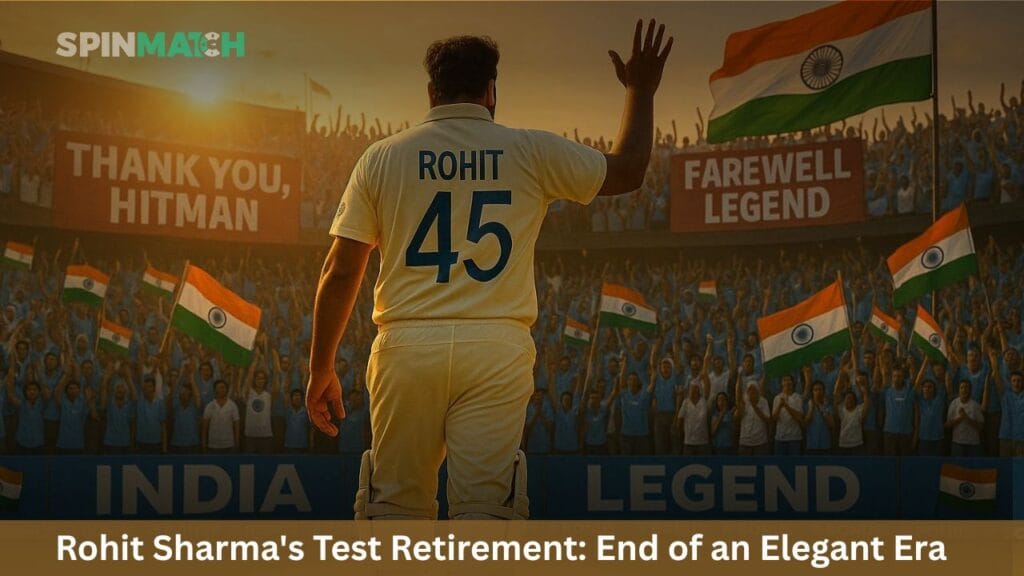Rohit Sharma’s Test Retirement: The Last Cap Down
Indian cricket fans woke up in the evening to stunned news on Wednesday when Rohit Sharma suddenly announced his immediate retirement from Test cricket with a short social media announcement. Contrary to the grand farewells extended to the majority of cricketing heroes, this departure was accompanied by little notice – a direct message together with a picture of his Test cap No. 280. Continue reading the blog by Spinmatch sports column on Rohit’s take on test cricket retirement.
An Unceremonious Exit
” Hello everyone, I would just like to share that I am retiring from Test cricket. It’s been an absolute honour to represent my country in whites. Thank you for all the love and support over the years. I will continue to represent India in the ODI format. “The 37-year-old tweeted on Instagram.
Interestingly, the announcement came shortly after a BCCI selection committee meeting in Mumbai – one that Rohit had skipped, reportedly due to a Mumbai Indians IPL game on the night of the announcement. The timing surprised everyone in the cricket community, particularly with a five-Test series in England to be played in a little over a month.
The Numbers Behind the Name
Rohit Sharma’s 11-year test career began in 2013 from his debut match against the West Indies in Kolkata, where he made his presence felt with a century. His statistical account is 4,301 runs from 67 games at an average of 40.57 with 12 centuries and 18 half-centuries. His top score – an authoritative 212 against South Africa in Ranchi in 2019 – told us about his ability to convert starts into big scores.
As captain, Sharma led India in 24 Tests with a winning record of 12 and a losing record of 9. India under Sharma’s captaincy made it to the final of the 2023 World Test Championship at The Oval, but lost to Australia.
Throughout his Test cricket career, Sharma’s batting was a blend of old-fashioned defence and elegant stroke-play. His pull shot was his signature – both his greatest asset and sometimes weakness. Against spinners, few contemporaries could match his rapid footwork and shot selection.
Recent Slumps That Signalled the Decline
A closer examination of Sharma’s recent performances reveals a batsman out of form:
- The Border-Gavaskar Trophy match against Australia was a debacle, with Rohit averaging only 6.20 in five matches as India lost the trophy 3-1
- Prior to the Australian debacle, his average was only 15.16 during the crushing 3-0 home series defeat to New Zealand
- On his return from Australia, a solitary Ranji Trophy match saw him score just 3 and 28 against Jammu & Kashmir
These showings indicated a batsman well gone from his best, or at least so it appeared in the extended format of the game.
Voluntary Departure or Soft Push?
Spinmatch Cricket insiders say that Sharma’s choice was not so much of his own volition. The selection committee had already discussed naming a new captain for the England tour, with Rohit’s poor red-ball performances a prominent point of concern, sources in the BCCI have confirmed.
“The committee is looking for a new captain of the England tour, and Rohit does not come as a captain, considering his red-ball performance as well. They want to groom a young captain for the next Test cycle,” a BCCI source is cited as having said by The Indian Express.
What makes this retirement of particular interest is Sharma’s previous insistence during the Sydney Test last January, where he resigned himself voluntarily due to poor form, that his absence was temporary. Speaking to the media afterward, he said: “I didn’t play this game because runs are not coming off my bat. There is no guarantee that runs won’t come five or two months later. I have seen a lot in cricket that life keeps on changing every second, every minute, every day.”
Sharma had also unequivocally claimed his autonomy over his career decisions: “They can’t make up their minds when we should retire, when we should rest, when we should be captain. I am a pragmatic man, a mature man, a father of two children. So I understand what I require in life.” That contrast to his later retirement raises proper questions regarding the circumstances behind this decision.
Leadership Vacuum and Succession Plans
Rohit Sharma’s Test retirement creates an immediate leadership vacancy that needs to be addressed before the England series begins on June 20 at Headingley. Jasprit Bumrah is the most obvious replacement, having been the vice-captain and having led India in Sharma’s absence in Australia.
But to leave the captaincy in the hands of a pace bowler who has recently returned from a stress reaction in his lower back is dangerous. The physical demands of pace bowling and the tactical demands of captaincy could ultimately undermine Bumrah’s strongest asset.
Other contenders have their own issues. Rishabh Pant has leadership potential but is still in the early stages of developing it. KL Rahul’s variable performances make one wonder if he has a place in the XI. Some cricket experts have even floated the idea of bringing back Ajinkya Rahane, whose previous leadership credentials include leading India to a historic series win in Australia. The Ajit Agarkar-headed selection panel has a crucial call to make that will chart India’s future in the new World Test Championship cycle.
A Career Transformed
Rohit Sharma’s Test career defied the norms of conventional narrative arcs. Stereotyped first as a limited-over specialist, he could not settle in the Test game for years. His fortunes turned dramatically in 2019 when he was promoted to open the batting – a change that rekindled his red-ball career and ensured his all-around nature.
As a Test opening specialist, Sharma found his métier, employing his excellent eye for length and innate sense of timing to nullify new-ball intimidators. His ability to move from watchful defence to measured attack rendered him a powerful challenge to visiting bowlers.
BCCI President Roger Binny acknowledged this shift in his obituary: “Mr Rohit Sharma’s contribution to Indian cricket transcends numbers and records. He brought a sense of calmness and confidence as player and captain. His level-headedness under pressure and his knack of always putting the team first made him an outstanding player and leader.”
Peeking into the White-Ball Horizons
This announcement doesn’t represent the fulfillment of Sharma on an international scale. Already, having resigned T20I duty after India triumphed at the T20 World Cup in June 2024, he is set to retain his Indian status in ODI cricket as leader.
At 37, Rohit appears to be strategically rallying his attention towards the 2027 ODI World Cup in South Africa, Zimbabwe, and Namibia. His extensive record and batting skills remain invaluable assets for India in the 50-over format, where his record is among the best in cricket history.
The Sharma Legacy in Tests
As the dust settles on Rohit Sharma’s Test retirement, fans reflect on a journey defined by grit and transformation. From a struggling middle-order batsman to a composed Test opener and India’s captain, Rohit’s evolution showcased resilience and class. Though often overshadowed by his white-ball success, his contributions in Test cricket—both as a batsman and leader—were invaluable. His calm leadership and technical mastery at the top will be hard to replace.
For many, Rohit Sharma in whites will be remembered for his signature pull shots, stylish late cuts, and unwavering determination. While his Test career ended without a grand farewell, his impact remains undeniable. Which part of Rohit Sharma’s Test legacy stands out most to you? Share your thoughts in the comments and follow Spinmatch for the latest cricket updates.







